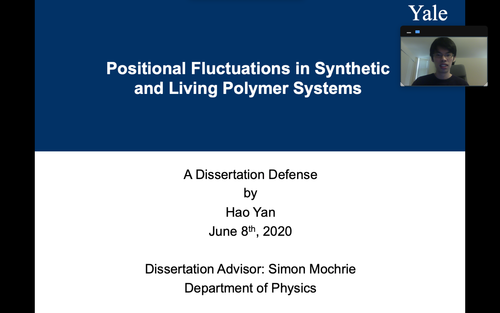
On June 8, 2020 Hao Yan successfully defended his thesis: “Positional Fluctuations in Synthetic and Living Polymer Systems” (Advisor: Simon Mochrie).
Yan explained “DNA is packaged into a complex macromolecular structure called chromatin. It compacts the DNA, allowing it to fit into the small size of a cell nucleus. The spatial organization and folding of chromatin within the nucleus is critical to many biological processes and functions. Also, chromatin organization is closely related to its dynamics. However, the mechanisms underlying this special organization are not fully understood. Collaborating with the biology group, I developed a new model that emphasizes the importance of genome in chromatin organization. Through numerical simulations, the model successfully recapitulates the experiment results. The model is further enhanced to explore chromatin dynamics by incorporating polymer properties. My work builds up a bridge between chromatin organization/dynamics and the genome architecture. This connection has not received enough attention before.”
Yan is still deciding what to do post degree.
Thesis abstract: “Chromatin organization is inextricably linked to its dynamics. The loop extrusion factor (LEF) model provides a framework for how topologically associating domains (TADs) arise: cohesin or condensin extrude DNA loops, until they encounter boundary elements, namely CTCF. However, a characteristic subdiffusive behavior of MSD is observed in fission yeast on the seconds timescale and experiments show that cohesin or condensin largely constrains chromatin mobility. Such finding is inconsistent with prior LEF model.
I develop a new LEF model in which LEF loading depends on the underlying architecture of transcriptional units and chromatin remodeling is identified as the essential ATP-dependent activity that drives chromosome motion. I demonstrate that this model predicts TADs, including TAD boundaries lacking CTCF binding sites, comparably well to prior CTCF-dependent LEF models for the mouse genome, and also successfully predicts TADs in the CTCF-lacking model, S. pombe. Lastly, I perform polymer dynamic simulations and show that the DNA-looping by cohesin and condensin largely constrain chromatin mobility, which is in agreement with experiments.”